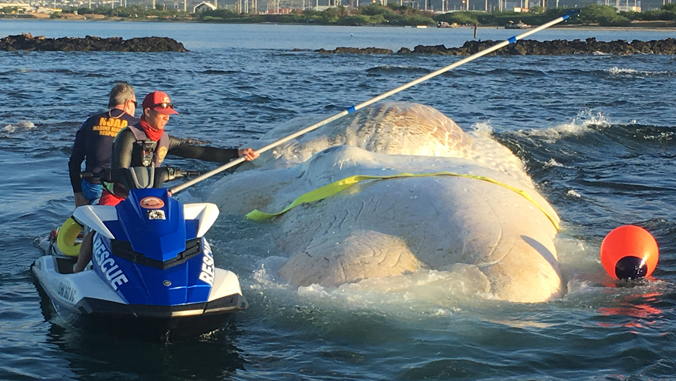
The sperm whale carcass that has plagued Oʻahu waters for most of January is providing scientists a unique opportunity to study the species and its ecological and cultural importance in Hawaiian waters. Three University of Hawaiʻi at Mānoa professors are part of the investigation.
The whale carcass first appeared on January 10 off Kewalo Basin on Oʻahu’s south shore. After being hauled out to sea, the remains washed up near Sand Island State Recreation Area. Crews towed the carcass about 2.5 miles out to sea about a week later. However, the remains washed up on a remote west-side beach.
Several agencies have participated in the investigation and removal including UH Mānoa’s Hawaiʻi Institute of Marine Biology (HIMB), William S. Richardson School of Law and Kamakakūokalani Center for Hawaiian Studies, the Department of Land and Natural Resources, National Oceanic and Atmospheric Administration’s Marine Mammal Response Team and the Honolulu Ocean Safety and Lifeguard Services Division.

HIMB Professor Kristi West, who leads the Marine Biology Marine Mammal Stranding Lab, says a necropsy on the whale showed no evidence that the animal ingested marine debris such as plastics.
“The main thing we looked at was stomach contents to help us better understand the whale’s diet. We did discover that the whale had not foraged for some time,” West said. “We also looked at exposed bone, which indicates this whale was probably 50-feet long.”
Teams recovered bones, teeth and tissue to study whether there are signs of disease or blunt-force trauma.
Malia Akutagawa, an assistant professor at the UH law school, is leading a team of students looking at how the carcass is degrading in place as part of the natural ecosystem.
“From a cultural standpoint we always look at the whale’s best interest, as they not only represent a large marine mammal, but in Hawaiian culture they represent our kupuna who traveled from far, distant places,” said Noelani Puniwai, UH Mānoa assistant professor of Hawaiian studies. “They are amazing messengers, as we can learn so much from them and help us to determine our own roles in the environment.”
Akutagawa wants to remind everyone that they should respect whales—dead or alive—as they are both culturally and scientifically significant.

